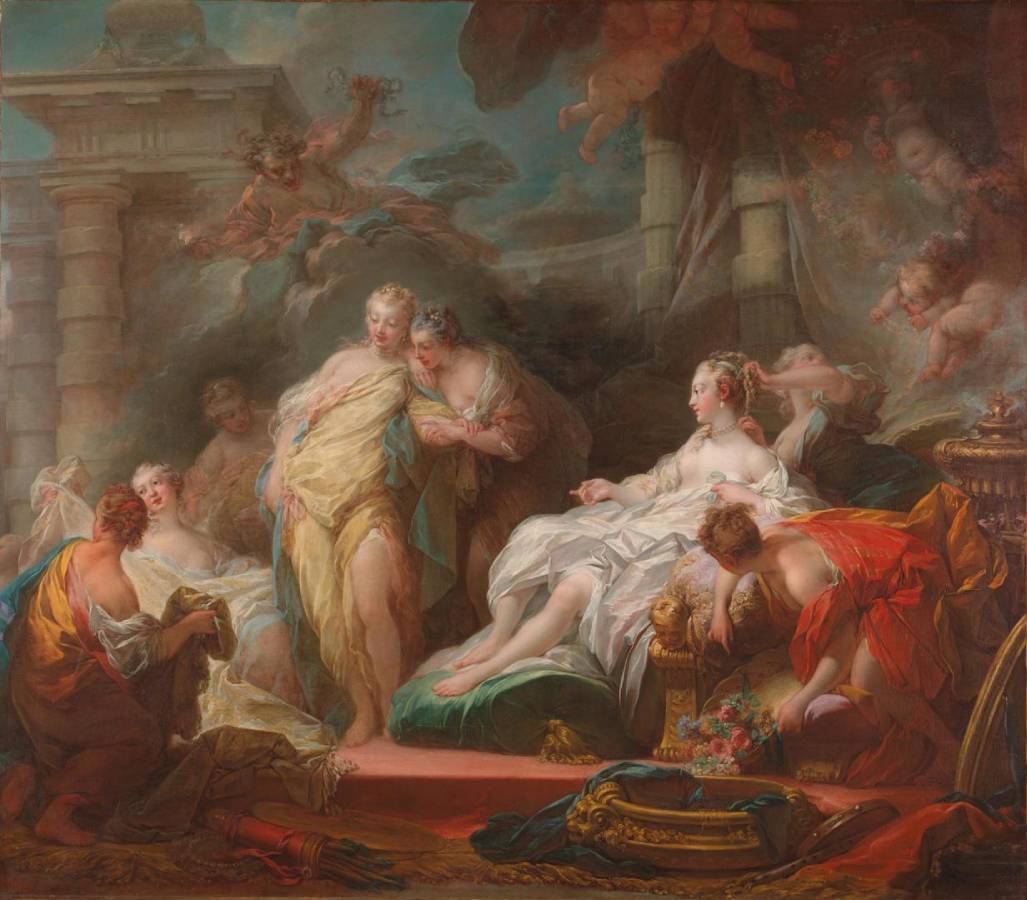Fragonard, Jean-Honoré (1732-1806)
Psyché montrant à ses soeurs les présents de l’amour (Psyche showing her Sisters her Gifts from Cupid)
1753
Oil on canvas, 168.3 × 192.4 cm
National Gallery, London
This painting illustrates an episode from the classical story of Cupid and Psyche. Having fallen in love with Psyche, Cupid only visited her at night, forbidding her to look at him. Here we see Psyche welcoming her two sisters into Cupid’s palace where she shows them the gifts she has received. Provoked by envy – represented by an allegorical figure above them who is clutching snakes – the two sisters persuade Psyche to reveal Cupid’s identity and thereby destroy her happiness.
The story was originally told by Apuleius (c.124–c.170 AD) in Book V: 7–10 of his Latin prose work Metamorphoses (also known as The Golden Ass). However, Fragonard’s painting – particularly the abundance of figures and objects – owes more to Jean de La Fontaine’s Les Amours de Psiché et Cupidon, which was first published in 1669 and frequently republished.
Some detail is now missing as the canvas has been cut down – it has lost around 26 cm from the top and around 35 cm on the left hand side. In what would originally have been the middle of the picture, the two sisters stand flanked by the giant columns of Cupid’s palace. On the right, Psyche, swathed in white, reclines as she is attended to by two nymphs, one of whom dresses her hair. Three more nymphs are on the left. Two are holding the fabrics that Psyche is showing to her sisters. Part of another (sixth) nymph can just be glimpsed at the very left edge of the picture. Fragonard has also filled the scene with an array of luxury items, including golden vases and a perfume burner, and Cupid’s full quiver lies on the ground. Flowers and jewels are scattered throughout. Jewellery, especially, was central to La Fontaine’s narrative, and it is possible that the piles of jewels he describes were originally in the bottom left corner of the picture before the canvas was cut down.
This is an early work by Fragonard, painted the year he was admitted as a pupil to the Ecole royale des élèves protégés, then under the direction of Carle Vanloo. At that time pupils at the school were required to produce a work to show to the King at Versailles. This painting was among those presented in 1753. It was an immediate success, but later passed into obscurity when it was also attributed to Vanloo. Before he arrived at the school, Fragonard studied with Boucher during 1752–3 and, perhaps not surprisingly, the picture shows the influence of the older painter. Many of its details derive from sketches made by Boucher in 1737 for a tapestry illustrating the same story. However, Fragonard’s painting shows more movement – for example, in the opposing diagonals of Psyche and the figure of Envy or the almost Baroque upward lift of the columns and putti. Fragonard’s colours are also sharper, such as the pale lemon dress of one of the sisters, its acidic tone perhaps denoting her envy.
It has been suggested that the figure of Psyche may have been inspired by the King’s mistress, Madame de Pompadour. She is shown later in life in Drouais’s Portrait of Madame de Pompadour at her Tambour Frame. (NG)
See also:
• Apuleius (c.124-c.170) | La Fontaine, Jean de (1621-1695) | Pompadour, Madame de (1721-1764)
